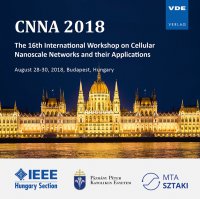Theory of CNNs with hafnium oxide RRAMs
Conference: CNNA 2018 - The 16th International Workshop on Cellular Nanoscale Networks and their Applications
08/28/2018 - 08/30/2018 at Budapest, Hungary
Proceedings: CNNA 2018
Pages: 3Language: englishTyp: PDF
Personal VDE Members are entitled to a 10% discount on this title
Authors:
Ascoli, Alon; Tetzlaff, Ronald (Institut für Grundlagen der Elektrotechnik und Elektronik, TU Dresden, Dresden, Germany)
Ielmini, Daniele (Dipartimento di Elettronica, Informazione e Bioingegneria, Politecnico di Milano, Milan, Italy)
Chua, Leon Ong (Dept. of Electrical Engineering and Computer Science, UC Berkeley, Berkeley, California)
Abstract:
The unique combined capability of memristor nanodevices to process signals and store data in the same physical volume may resolve the performance bottleneck of current purely-CMOS visual microprocessors, in which only a limited number of computing structures, known as Cellular Nonlinear Networks, may be integrated on top of image sensor arrays. The reason behind the poor spatial resolution of these smart sensors lies in the large integrated circuit area used up by each processing element in the multivariate signal processing cellular networks, mainly due to the need to endow them with data storage functionality, with obvious advantages in terms of computing speed. Memristor technologies may resolve this performance bottleneck since they are able to combine both signal processing and data storage capabilities within a nanoscale volume. As a result, their use in novel CNN hardware implementations may obviate the need for apposite memory blocks within each processing element. Furthermore, the peculiar nonlinear dynamics of memristors may be harnessed to extend or enhance the signal processing functionalities of CNNs. In this work we establish the theoretical foundations of a diffusivelycoupled Memristor CNN in which the linear resistor appearing in the standard CNN cell implementation is replaced by a hafnium oxide resistive random access memory device, including a series transistor limiting the current flowing through the memristor during on switching. Adopting an accurate physics-based model for the hafnium oxide resistance switching memory, a thorough theoretical investigation of the Dynamic Route Map of the memristor CNN cell allows to gain a deep understanding of the working principles of the novel nonlinear dynamic array. Numerical simulations covering a large number of image processing operations validate the theoretical developments, and reveal the add-on functionalities memristors endow the proposed network with, including the fascinating possibility to store and retrieve data, an impossible task for standard implementations.


